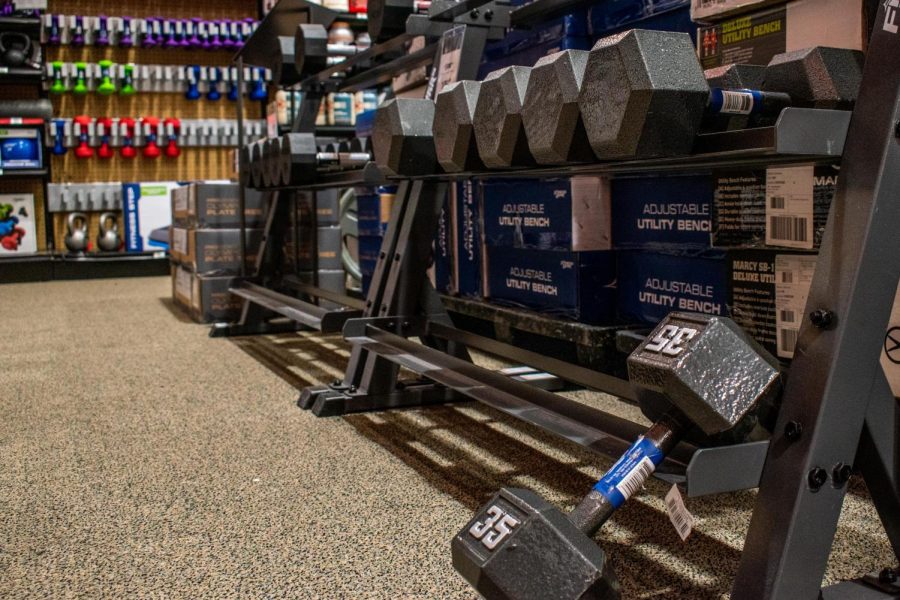Gym equipment shelves vacant as home workout popularity skyrockets amid pandemic
Andew Burke-Stevenson
The shelves of sporting goods stores are left empty as they struggle to keep up with demand.
February 1, 2021
Store shelves lie empty and footsteps echo through the bare aisles. A few scattered items — dusty mouth guards, sports tape in half-crushed packaging, and long-expired sales tags — litter the linoleum floor, while generic store music plays ominously in the background over dying speakers. Abandoned carts sit in every corner, some with almost-purchased items still inside. The dim fluorescent lights flicker occasionally and cast an eerie glow over the store. This isn’t a scene from a post-apocalyptic movie, it’s the fitness section at a sporting goods store in the Chicago suburbs.
Home gym equipment has become a nearly unobtainable item since the coronavirus pandemic began in March 2020, and once-reliable retailers have struggled to keep up with demand.
Prior to last March, home gyms were not commonplace for the average person. Most fitness enthusiasts had memberships to gyms with an abundance of weights and expensive machines. Now that conventional facilities are not available or are too much of a risk in spreading the coronavirus, a high demand for consumer workout equipment has left the country struggling to import or manufacture enough exercise equipment to meet demand.
Peloton purchaser Kelly Ramos, who lives in Chicago with her husband and children, said she ordered a Peloton exercise bike in late September and received it in mid-October. Ms. Ramos said contacting the company and doubling up orders with a family member expedited the process and allowed for reasonable shipment times.
“By syncing up my order with my sister next door, we got on the company’s radar and sped up the wait times,” Ms. Ramos said.
According to the New York Post, Peloton saw a 172% surge in total revenue in mid-September, compared to one year prior.
Hoyt Vanderkaap, a lifelong lifter and gym rat, has spent the months since the pandemic began dealing with price gouging and out-of-stock notifications from retailers.
“It’s been a struggle to find proper gear, mate,” Mr. Vanderkaap said. “I’m working with what I can get, wherever I can find it.”
He managed to find equipment by scouring Amazon for deals and approaching in-person shops for a heads-up phone call when shipments arrive.
Lab senior Avi Keysar, a fitness enthusiast, said, “I bought the Bowflex dumbbells right on time, and I checked a couple months later and they were either sold out or three times the price.”
Ryan Nygren, a senior at Lane Tech High School who has been recruited to play college lacrosse, said only cheap equipment is available online and that only a few local stores have items left. He said being trapped at home made him weightlift more consistently than before, but because he only uses available equipment in his garage, it has limited his options.
“When I was looking for a good bench, we drove all over the city and suburbs and found nothing,” Ryan said.
As of this month, the supply of fitness equipment is steadily returning to its pre-pandemic state. Although the show floors of big box retailers remain empty, online shops and small suppliers are beginning to get more items in stock each day. Gyms have begun to reopen, and demand for home gyms is slowly declining. Even with the market returning to normal, the residual effects of the pandemic surge will linger in the minds of store owners and customers alike, and the availability of equipment is still hit or miss.
Store aisles may be cleaned up, but the shelves remain mostly empty. As listings from Amazon and other online retailers increase, the availability of gym equipment is brighter — and a lot less post-apocalyptic.































































